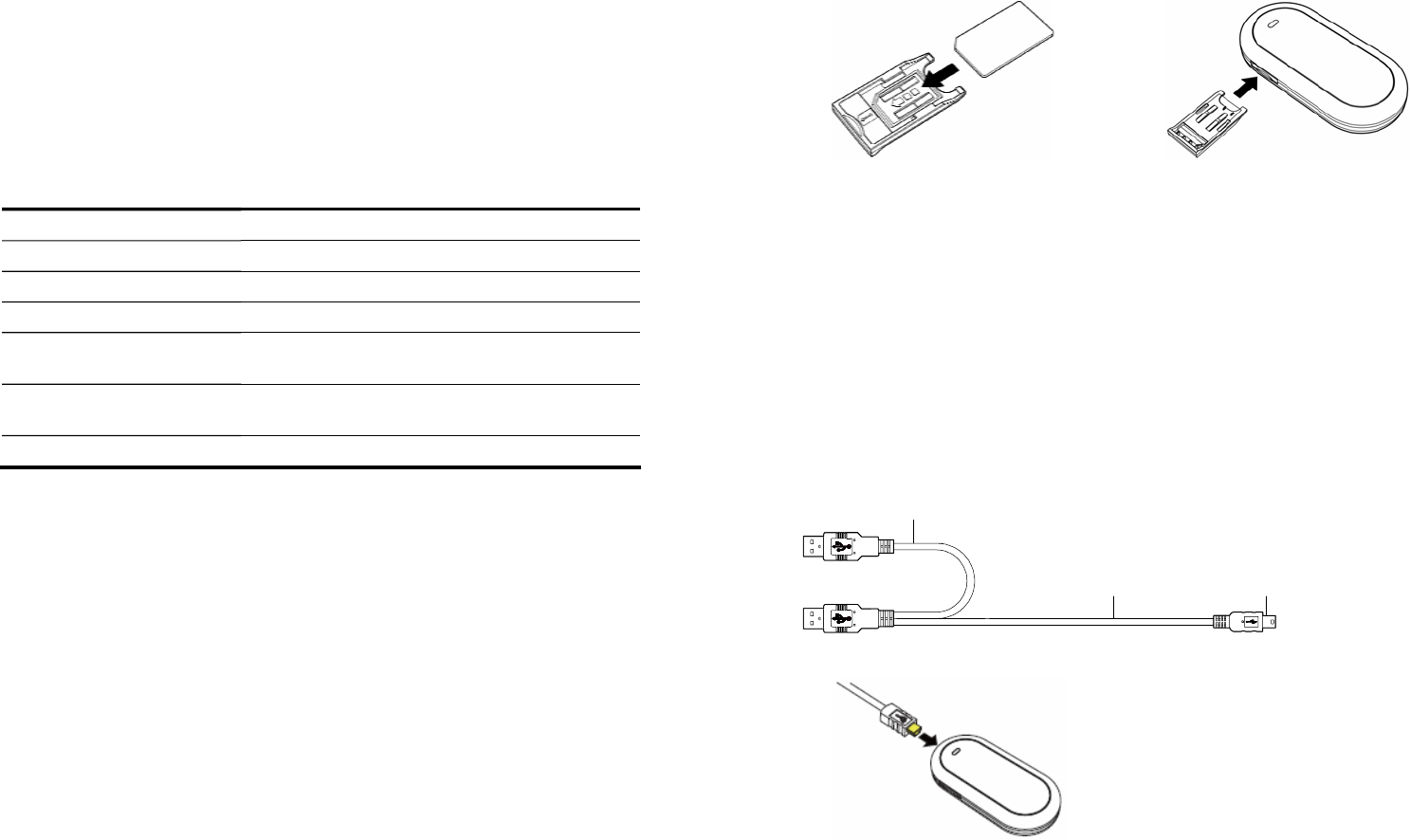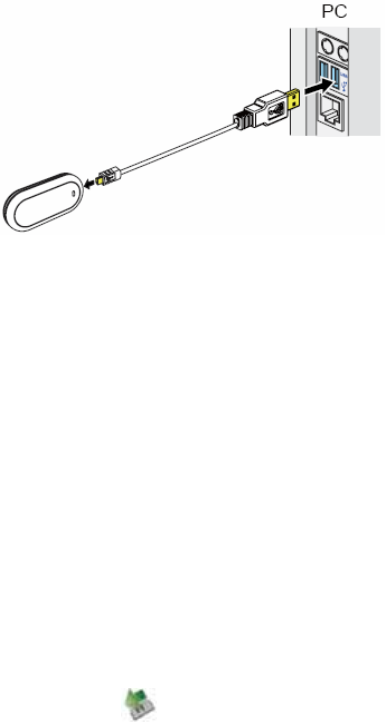Huawei Technologies EC226 CDMA EV-DO USB Modem User Manual
Huawei Technologies Co.,Ltd CDMA EV-DO USB Modem
User Manual

Copyright © 2007 Huawei Technologies Co.,
Ltd.
All Rights Reserved
No part of this manual may be reproduced or transmitted in any
form or by any means without prior written consent of Huawei
Technologies Co., Ltd.
Trademarks
and HUAWEI are trademarks of Huawei Technologies Co., Ltd.
All other trademarks mentioned in this manual are the property of
their respective holders.
Notice
The information in this manual is subject to change without notice.
Every effort has been made in the preparation of this manual to
ensure accuracy of the contents, but all statements, information,
and recommendations in this manual do not constitute the warranty
of any kind, expressed or implied.
i
Table of Contents
Getting to Know Your EC226 1
Requirements for the Computer 2
Getting the EC226 Ready 3
Installation Guide 3
Warnings and Precautions 5
Technical Specifications 8

1
Thank you for purchasing Huawei EC226 EV-DO USB Modem (hereinafter
referred to as EC226).
EC226 is a wireless device based on the CDMA2000 1x and CDMA2000
1xEV-DO Rev. A protocols. From your computer, you can communicate with
all benefits of CDMA technology on CDMA networks at a high speed.
EC226 provides data transmission at up to 3.1 Mbit/s download with
receiving diversity technology, and up to 1.8 Mbit/s upload.
Note: Download and Upload speeds may vary based on network and environmental
factors.
This manual briefs the profiles of EC226, including the preparation,
installation/uninstall process, and safety precautions.
You are highly recommended to read the manual before using the EC226.
Getting to Know Your EC226
This is a sketch for EC226. The actual product may differ.
USB interface
USIM/SIM card slot Indicator
2
Indicator
Indicates the status of the EC226.
Indicator Status Description
On The EC226 is powered on.
Blinking once every 2s y The EC226 is searching the network.
y The network is not found.
Blinking twice every 2s The network is found.
Blinking once every 0.2s The EC226 is engaged in a call or a data
service.
Off The EC226 is removed, powered down, or
reset.

3
Requirements for the
Computer
To correctly install and use EC226, the following configurations for the
computer are required.
Item Required Configuration
USB interface USB 2.0 Full Speed
CPU 866 MHz Pentium or above
Memory 128 MB or above
Free space on the hard
disk 100 MB or above
Operating system Windows XP, Windows 2000 or Window
Vista
Screen resolution 1024 × 768 is recommended
Note: Improper configurations may degrade the computer performance. Make sure
that the computer configurations meet the requirements.
For Windows XP, it is recommended to install patches such as Service Pack 2 or
above.
For Windows 2000, it is recommended to install patches such as Service Pack 4
or above.
Getting the EC226 Ready
Note: Make sure whether your EC226 need a UIM card, contact your service provider.
If your EC226 need a UIM card, insert the UIM card into EC226 as follows.
1. Remove the User Identity Module (UIM) card slot from the EC226. Then
insert the UIM card into the card slot. Make sure that the UIM card is
fully in place.
2. Insert the card slot into the EC226.
4
Installation Guide
The procedure for installing is subject to the operating system installed on
your computer. The following section takes Windows XP as an example. If
there is any difference, follow the actual installation prompts.
Connecting the EC226 with a Computer
Note: First, power on a computer. Then connect the EC226 with the computer.
Otherwise, the normal installation of the EC226 can be affected.
The following figure is the sketch map of the data cable.
Auxiliary USB data cable
Main USB data cable Mini-USB Connetor
1. Plug the mini-universal series bus (USB) connector into the EC226.
2. Plug the connectors of the main USB data cable and the auxiliary USB
data cable into the USB interfaces of the computer.

5
Installing the Management Program
1. Connect the EC226 with the computer.
2. The OS auto detects and recognizes new hardware and starts the
installation wizard.
Note: If the auto-run program does not respond, go to the driver path. Find and
double-click the AutoRun.exe, and then the program will run.
3. Follow the prompts of the installation wizard.
4. After the program is installed, the shortcut icon for management
program is displayed on the desktop.
Removing the EC226
Follow these steps strictly to remove the EC226 from your PC. Otherwise,
your system may be damaged, even if it is in the standby mode.
Note: Before removing the EC226, you need to log out of the management program
first.
1. Double-click in the system tray.
The Safely Remove Hardware interface is displayed.
2. Select Huawei Device (actual name based on the name displayed in this
menu – "Huawei Mobile Connect - 3G Modem" for example) in the
Hardware devices list, and click Stop.
The Stop a Hardware device interface is displayed.
3. Click OK.
4. When the Safe To Remove Hardware prompt is displayed, click OK
and remove the EC226.
Starting the Management Program
Double-click the shortcut icon on the desktop to start the management
program.
Uninstalling the Management Program
1. Click Start Menu.
6
2. Click Control Panel.
3. Find the management program, and click Add/Remove Program to
uninstall it.
7
Warnings and Precautions
Please read the safety information carefully to ensure the correct and safe
use of your wireless device.
General Recommendations for Use
Always handle your wireless device with care and keep it in a clean and
dust-free place. Do not expose your wireless device to open flames or lit
tobacco products.
y Always keep your wireless device dry.
y Do not drop, throw or try to bend your wireless device.
y Do not paint or scratch your wireless device.
y Do not attempt to disassemble your wireless device. Doing so will void
warranty. Only authorized personnel are allowed to do so.
y Use approved accessories only. Do not connect your wireless device to
any incompatible products.
Laws and Regulations
y Do not operate your wireless device where it may be unsafe to do so or
where you are required not to do so.
y To deactivate your wireless device, stop all applications using the wireless
device first and then remove the wireless device from your PC.
y Obey all local laws, regulations, rules, orders, signs and notices while
using the wireless device. Signs about the use of mobile phones should
also be obeyed as referring to other wireless equipment including wireless
devices provided by Huawei.
Electronic Device
y Deactivate your wireless device near high-precision electronic devices.
The wireless device may affect the performance of these devices.
y Pacemaker manufacturers recommend that a minimum separation of 20
cm be maintained between a wireless device and a pacemaker to avoid
potential interference with the pacemaker. Deactivate your wireless
device, if it may have disturbance to the pacemaker.
Deactivate in Explosive Areas
Deactivate your wireless device where the air is potentially explosive. It is
rare, but your PC could generate sparks.
Deactivate in Blasting Areas
Deactivate your wireless device where blasting is in progress.
Remote-controlled radio frequency (RF) devices are often used at
8
construction sites to set off blasting.
Deactivate in Aircrafts
Deactivate your wireless device before boarding or in any aircraft. Wireless
devices can cause interference in aircrafts.
Deactivate at Hospitals
Obey regulations or rules at hospitals. Deactivate your wireless device near
medical equipment. Wireless devices can cause interference to cardiac
pacemakers, implanted defibrillators or other medical equipment.
Deactivate near Hearing Devices
Deactivate your wireless device near hearing devices. People with hearing
aids may experience interfering noise near wireless devices.
Recommendations for Children
Do not allow children to play with your wireless device. They could hurt
themselves or others, or could accidentally damage the wireless device.
Your wireless device contains small parts with sharp edges that may cause
an injury or a choking hazard.
Deactivate While Driving
Do not use the wireless device while driving.
Immunity to Interference
Your wireless device is immune to interferences caused by audible signals.
Cleaning and Maintenance
y Before you clean or maintain the wireless device, stop all applications
using the wireless device and remove your wireless device from your PC.
y Clean your wireless device with a piece of soft antistatic cloth.
y If the wireless device or any of its accessories does not work, turn to an
authorized service center for help.
Environmental Protection
Observe the local regulations regarding the disposal of your packaging
materials, old wireless device and its accessories. Please promote their
recycling.
SIM/USIM Cards
While inserting or removing the SIM card, protect yourself against
electrostatic discharge (ESD). Do not touch the connector of the SIM card.
As a precaution, always make sure that the wireless device is already in
your hand before you insert or remove the SIM card.
Restart on ESDs
Software will attempt to re-initialize a connection once a substantial
electrostatic discharge causes the device to reset. If the software is not
operational after an ESD, restart the software application.
9
Agency/Regulatory Information
The wireless device is approved for use in many regions of the world. In
these regions, the device meets all radio frequency exposure requirements.
The following approvals and notices apply in specific regions as noted.
CE Approval (European Union)
The wireless device is approved to be used in the member states of the EU.
Huawei declares that the wireless device is in compliance with the essential
requirements and other relevant provisions of the Radio and
Telecommunications Terminal Equipment Directive 1999/5/EC (R&TTE
Directive).
Radiofrequency radiation exposure Information
This equipment complies with FCC radiation exposure limits set forth for an
uncontrolled environment. This equipment should be installed and
operated with minimum distance of 20 cm between the radiator and your
body.
This transmitter must not be co-located or operating in conjunction with
any other antenna or transmitter.
FCC Statement
This device complies with Part 15 of the FCC Rules. Operation is subject to
the following two conditions: (1) this device may not cause harmful
interference, and (2) this device must accept any interference received,
including interference that may cause undesired operation.
Class B Digital Device
This equipment has been tested and found to comply with the limits for a
Class B digital device, pursuant to Part 15 of the FCC Rules. These limits are
designed to provide reasonable protection against harmful interference in a
residential installation. This equipment generates, uses and can radiate
radio frequency energy and, if not installed and used in accordance with the
instructions, may cause harmful interference to radio communications.
However, there is no guarantee that interference will not occur in a
particular installation.
If this equipment does cause harmful interference to radio or television
reception, which can be determined by turning the equipment off and on,
the user is encouraged to try to correct the interference by one or more of
the following measures:
y Reorient or relocate the receiving antenna.
y Increase the separation between the equipment and receiver.
y Connect the equipment into an outlet on a circuit different from that to
which the receiver is connected.
y Consult the dealer or an experienced radio/TV technician for help.
10
Warning:
Changes or modifications made to this equipment not expressly approved by
HUAWEI may void the FCC authorization to operate this equipment.
FCC ID: QISEC226

11
Technical Specifications
Item Description
USB interface USB 2.0 full speed
Frequency band 800 MHz/1900 MHz
Data service y UL: Up to 1.8 Mbit/s
y DL: Up to 3.1 Mbit/s
Dimensions (D×W×H) 89.4 mm/42.6 mm/14.5 mm
Weight About 50 g
Battery Powered via the USB interface
Operating temperature –10℃ to +55℃
Storage temperature –40℃ to +70℃
Humidity 5% to 95%
Version: V100R001_01 Part Number: 31018249